Abstract
Usefulness of two enzyme-linked immunosorbent assays (ELISA) for screening of dairy herds for antibodies to lipopolysaccharide (LPS) of Salmonella dublin (O:1,9,12) was investigated. Sera (3097) were collected from 40 dairy herds located in three areas of Denmark with different prevalence of salmonellosis: ten salmonellosis-free herds from the island of Samsø where there is no history of salmonellosis, ten salmonellosis-free herds from the island of Sealand where outbreaks are infrequent, and 20 salmonella infected herds from Jutland where salmonellosis is enzootic. The samples were analyzed for antibodies to S. dublin LPS using an indirect (O:9,12) and a blocking (O:9) ELISA. Using herd history of salmonellosis, herd location and clinical state of the herds as reference, the herd sensitivity and herd specificity of the tests were 100% and 100% in the indirect ELISA and 95% and 100% in the blocking ELISA, respectively. A significant correlation was found between the two tests (rs = 0.46, p < 0.001). However, the indirect ELISA detected more seropositive animals than the blocking ELISA (17% vs. 7%, respectively). In calves from Sealand, level of background reaction was significantly lower (p < 0.001) compared to the heifers and the cows. The percentages of seropositive calves in both tests were higher (p < 0.01) in comparison to cows (19 vs. 8 in indirect ELISA, and 14 vs. 6 in blocking ELISA, respectively). Results of the study indicated that it is possible to apply LPS ELISA in serological screening for salmonellosis.
Full text
PDF
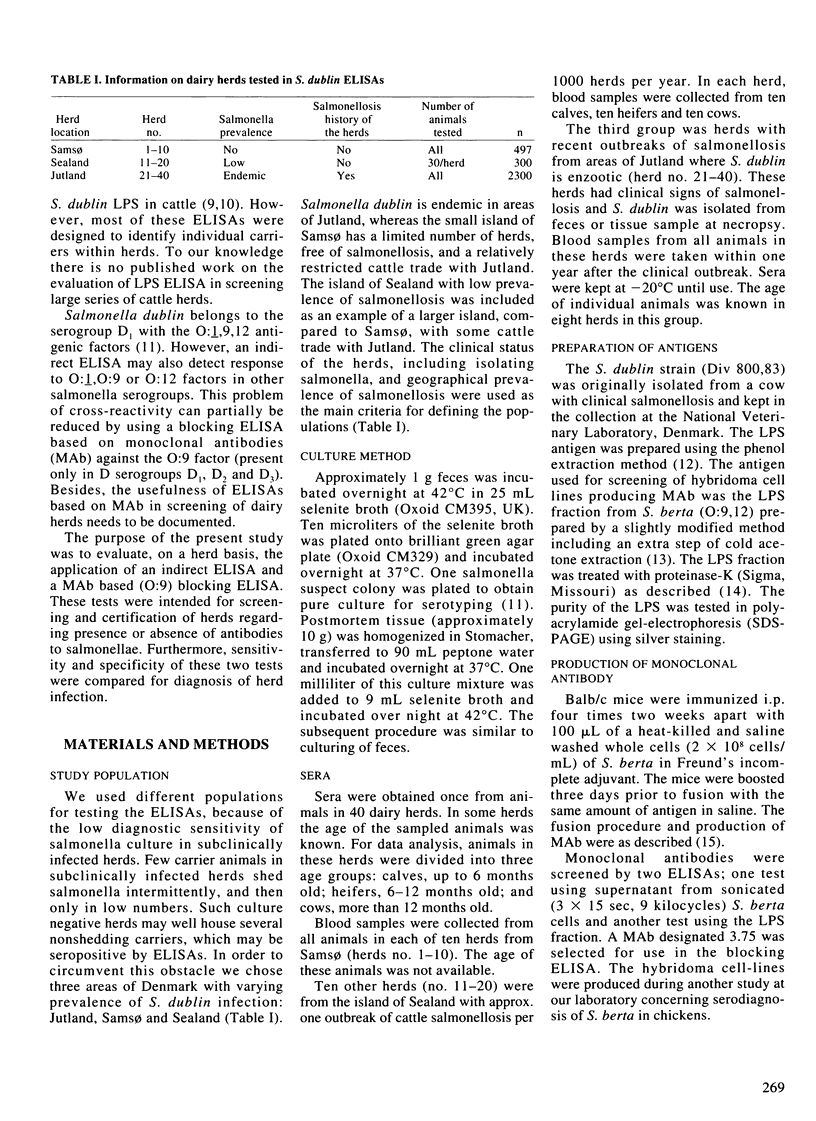
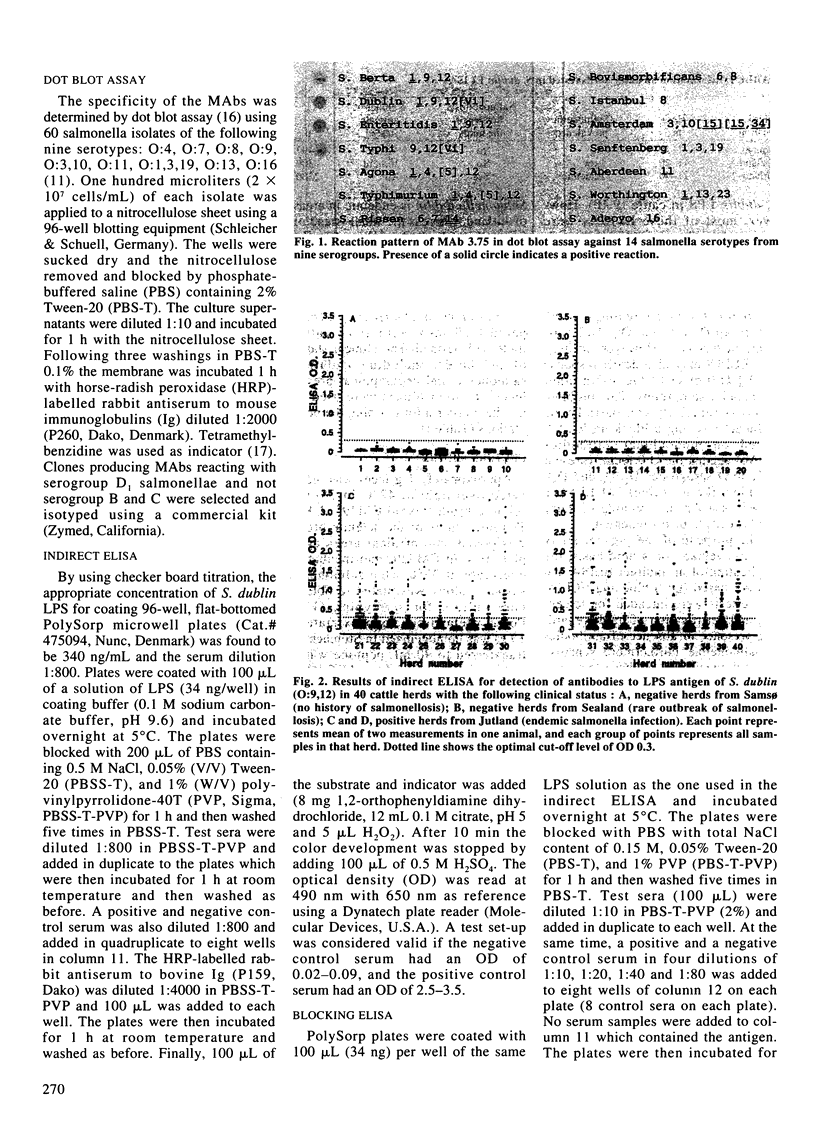

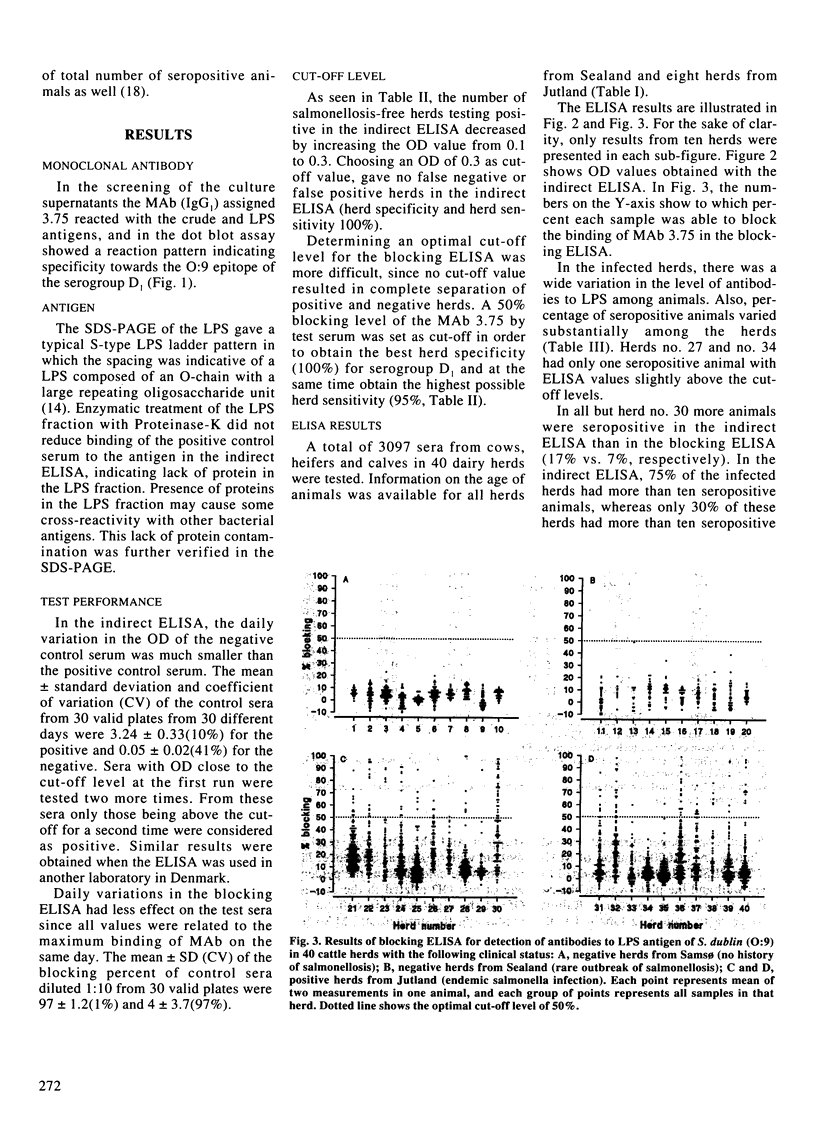
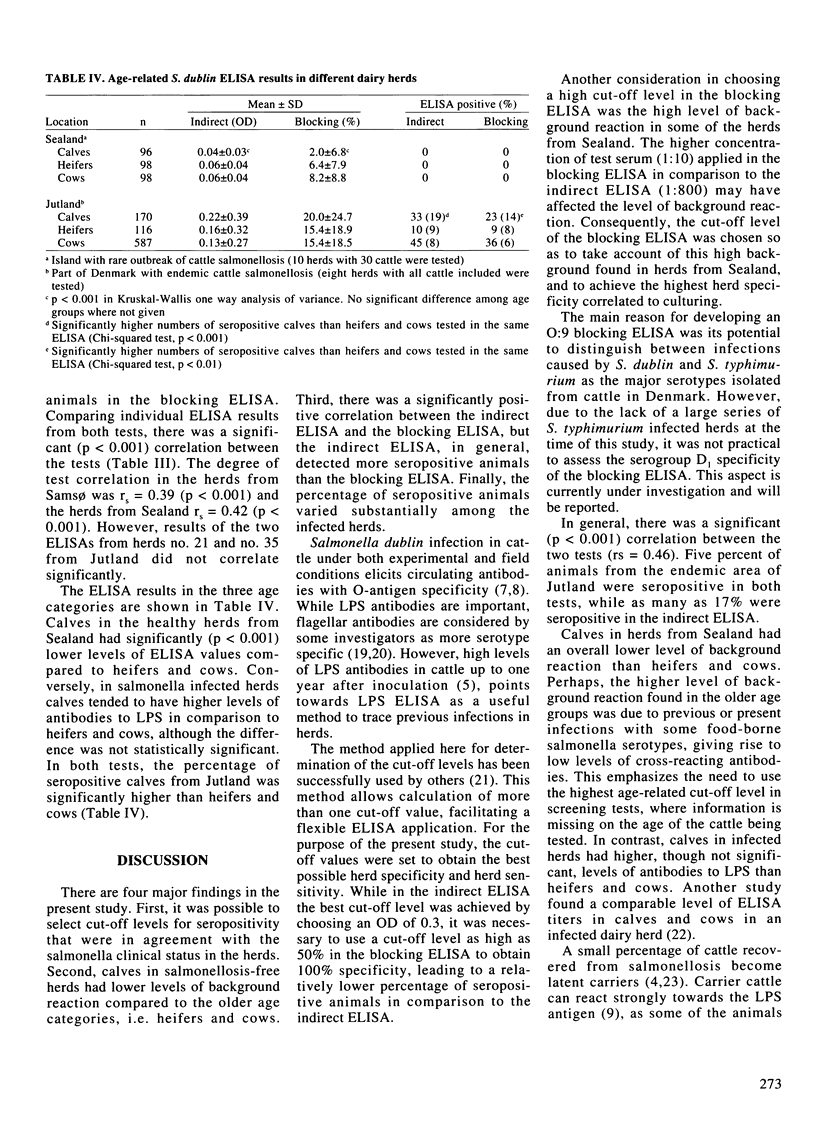
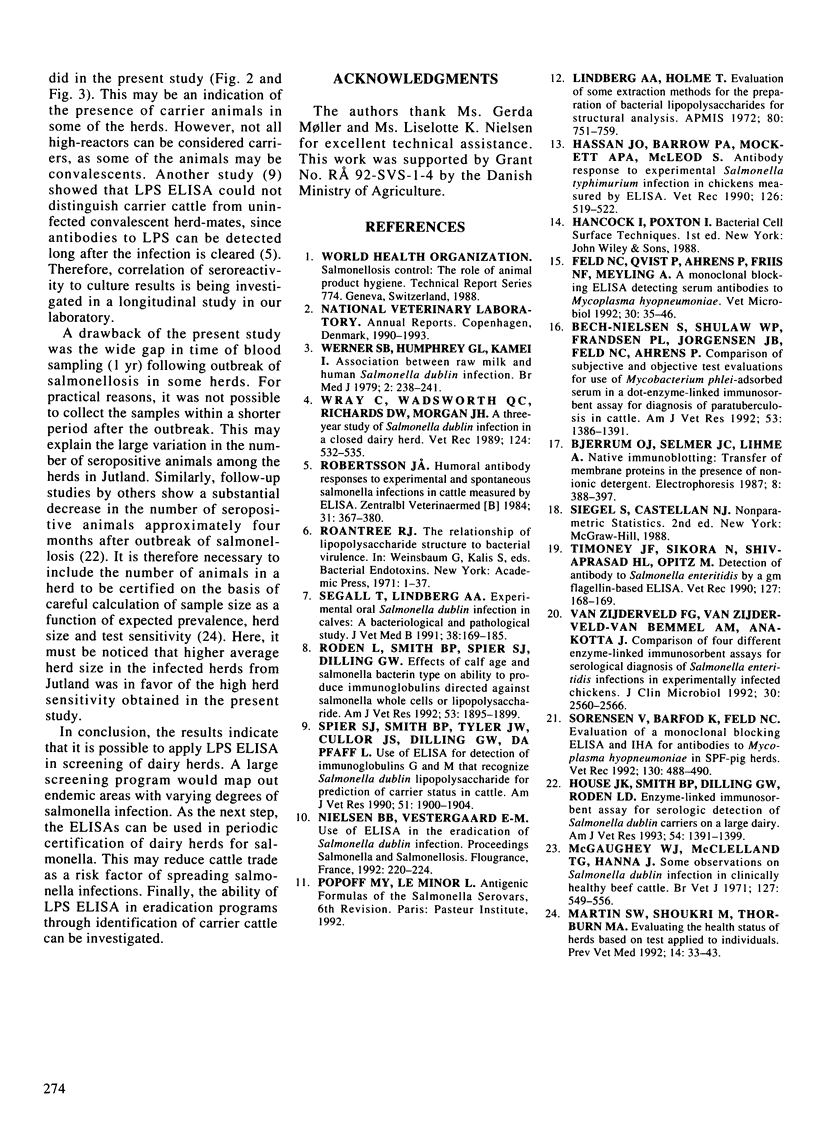
Selected References
These references are in PubMed. This may not be the complete list of references from this article.
- Bech-Nielsen S., Shulaw W. P., Frandsen P. L., Jorgensen J. B., Feld N. C., Ahrens P. Comparison of subjective and objective test evaluations for use of Mycobacterium phlei-adsorbed serum in a dot-enzyme-linked immunosorbent assay for diagnosis of paratuberculosis in cattle. Am J Vet Res. 1992 Aug;53(8):1386–1391. [PubMed] [Google Scholar]
- Da Roden L., Smith B. P., Spier S. J., Dilling G. W. Effect of calf age and Salmonella bacterin type on ability to produce immunoglobulins directed against Salmonella whole cells or lipopolysaccharide. Am J Vet Res. 1992 Oct;53(10):1895–1899. [PubMed] [Google Scholar]
- Feld N. C., Qvist P., Ahrens P., Friis N. F., Meyling A. A monoclonal blocking ELISA detecting serum antibodies to Mycoplasma hyopneumoniae. Vet Microbiol. 1992 Jan;30(1):35–46. doi: 10.1016/0378-1135(92)90092-8. [DOI] [PubMed] [Google Scholar]
- Hassan J. O., Barrow P. A., Mockett A. P., Mcleod S. Antibody response to experimental Salmonella typhimurium infection in chickens measured by ELISA. Vet Rec. 1990 May 26;126(21):519–522. [PubMed] [Google Scholar]
- House J. K., Smith B. P., Dilling G. W., Roden L. D. Enzyme-linked immunosorbent assay for serologic detection of Salmonella dublin carriers on a large dairy. Am J Vet Res. 1993 Sep;54(9):1391–1399. [PubMed] [Google Scholar]
- Lindberg A. A., Holme T. Evaluation of some extraction methods for the preparation of bacterial lipopolysaccharides for structural analysis. Acta Pathol Microbiol Scand B Microbiol Immunol. 1972;80(5):751–759. doi: 10.1111/j.1699-0463.1972.tb00203.x. [DOI] [PubMed] [Google Scholar]
- Robertsson J. A. Humoral antibody responses to experimental and spontaneous Salmonella infections in cattle measured by ELISA. Zentralbl Veterinarmed B. 1984 Jun;31(5):367–380. doi: 10.1111/j.1439-0450.1984.tb01314.x. [DOI] [PubMed] [Google Scholar]
- Segall T., Lindberg A. A. Experimental oral Salmonella dublin infection in calves. A bacteriological and pathological study. Zentralbl Veterinarmed B. 1991 May;38(3):169–185. doi: 10.1111/j.1439-0450.1991.tb00859.x. [DOI] [PubMed] [Google Scholar]
- Sorensen V., Barfod K., Feld N. C. Evaluation of a monoclonal blocking ELISA and IHA for antibodies to Mycoplasma hyopneumoniae in SPF-pig herds. Vet Rec. 1992 May 30;130(22):488–490. doi: 10.1136/vr.130.22.488. [DOI] [PubMed] [Google Scholar]
- Spier S. J., Smith B. P., Tyler J. W., Cullor J. S., Dilling G. W., Da Pfaff L. Use of ELISA for detection of immunoglobulins G and M that recognize Salmonella dublin lipopolysaccharide for prediction of carrier status in cattle. Am J Vet Res. 1990 Dec;51(12):1900–1904. [PubMed] [Google Scholar]
- Timoney J. F., Sikora N., Shivaprasad H. L., Opitz M. Detection of antibody to Salmonella enteritidis by a gm flagellin-based ELISA. Vet Rec. 1990 Aug 18;127(7):168–169. [PubMed] [Google Scholar]
- Werner S. B., Humphrey G. L., Kamei I. Association between raw milk and human Salmonella dublin infection. Br Med J. 1979 Jul 28;2(6184):238–241. doi: 10.1136/bmj.2.6184.238. [DOI] [PMC free article] [PubMed] [Google Scholar]
- Wray C., Wadsworth Q. C., Richards D. W., Morgan J. H. A three-year study of Salmonella dublin infection in a closed dairy herd. Vet Rec. 1989 May 20;124(20):532–537. doi: 10.1136/vr.124.20.532. [DOI] [PubMed] [Google Scholar]
- van Zijderveld F. G., van Zijderveld-van Bemmel A. M., Anakotta J. Comparison of four different enzyme-linked immunosorbent assays for serological diagnosis of Salmonella enteritidis infections in experimentally infected chickens. J Clin Microbiol. 1992 Oct;30(10):2560–2566. doi: 10.1128/jcm.30.10.2560-2566.1992. [DOI] [PMC free article] [PubMed] [Google Scholar]


